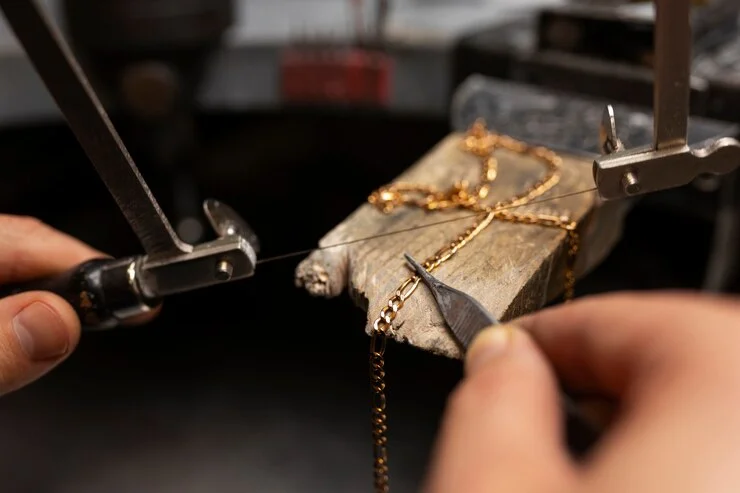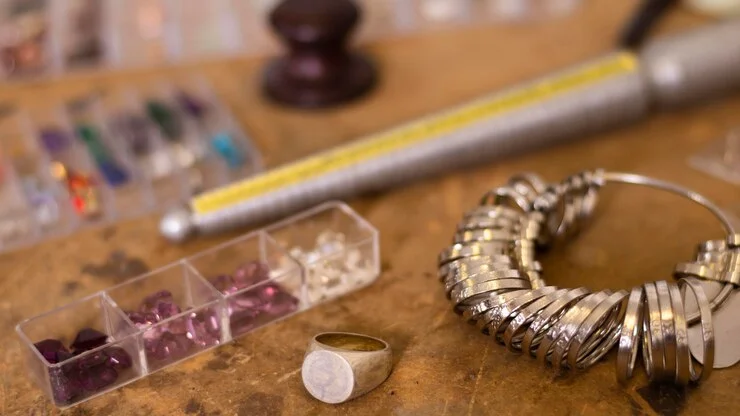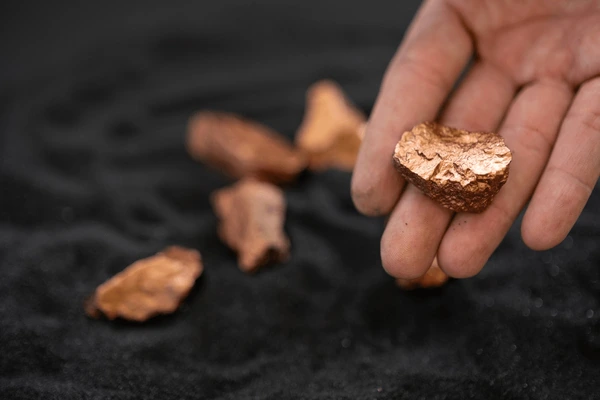Sayanava Sinha Roy
10.01.2025
Steps to Follow During Jewelry Manufacturing Inspections
Explore the essential steps to follow during jewelry manufacturing inspection to ensure the highest standards of quality and craftsmanship. Learn from one of the best gold buyers to enhance your production process, minimize defects, and deliver flawless jewelry that exceeds customer expectations and strengthens your brand’s reputation.
Table of Contents

Essential Steps for Jewelry Manufacturing Inspections
Jewelry manufacturing inspections play a critical role in the creation of beautiful, durable, and high-quality pieces. Whether you’re a jewelry maker or an established brand, ensuring each piece meets the highest standards of quality is essential. By conducting jewelry manufacturing inspections at various stages, you can prevent defects, ensure precision, and ultimately deliver flawless jewelry to your customers.
In this article, we’ll explore the essential steps to follow during jewelry manufacturing inspections, providing insights into how these checks can help you maintain the highest level of craftsmanship. We’ll also show you how these practices can positively impact your reputation and bottom line in the competitive jewelry industry.
The Importance of Jewelry Manufacturing Inspections
Jewelry manufacturing inspections are more than just a necessary part of the production process—they’re essential to ensuring your jewelry meets all expectations and regulations. These inspections focus on quality control, precision, and customer satisfaction. Here’s why jewelry inspections matter:
- Preventing Defects: Identifying issues during the manufacturing process prevents defective products from reaching customers.
- Maintaining Consistency: Regular inspections ensure consistency in quality and craftsmanship across every piece produced.
- Reducing Returns: By catching problems early, you minimize the risk of returns due to faulty items.
- Building Trust: High-quality products foster trust with your customers, leading to repeat business and positive word-of-mouth.
Proper jewelry manufacturing inspections ensure that each piece meets both aesthetic and functional requirements, providing customers with high-quality, long-lasting jewelry.

Key Steps to Follow During Jewelry Manufacturing Inspections
Jewelry manufacturing inspections should be conducted at different stages of the production process. Here’s a step-by-step guide to help you ensure that the entire process runs smoothly:
Step 1: Pre-Production Inspection
Before any actual production begins, pre-production inspections are critical for setting the right foundation for quality. Here’s what needs to be done during this phase:
- Sourcing Materials: Ensure that the raw materials used in your jewelry, such as metals, gemstones, and diamonds, meet industry standards and are certified authentic. Always request material certificates to verify their quality.
- Design Verification: Double-check the design specifications, sketches, and CAD models to ensure they align with customer requirements and production capabilities. Address any discrepancies before production begins.
- Prototyping: Often, jewelry manufacturers create a prototype of the piece to ensure that all measurements, settings, and overall design are achievable. This step helps confirm that the design can be executed successfully before moving forward with mass production.
The pre-production inspection lays the groundwork for the rest of the manufacturing process, ensuring that everything from the materials to the design is aligned for quality outcomes.
Step 2: In-Process Quality Control
Once production has begun, it’s important to monitor the jewelry at every stage of the manufacturing process. Here’s what you should focus on during in-process quality control:
- Checking Dimensions and Specifications: As the piece is being crafted, ensure that it is in line with the specified measurements and design requirements. Incorrect sizes or proportions can impact both the aesthetics and functionality of the jewelry.
- Soldering and Assembly Checks: Inspect all soldering and assembly work to ensure that joints are secure and that there is no visible gap between parts.
- Stone Setting Verification: Ensure that gemstones are set correctly, paying special attention to their alignment, and making sure they are secure to prevent them from falling out.
- Craftsmanship and Detailing: Inspect intricate work like engraving, texturing, and any other fine details. Ensure that these details are executed precisely as per the design.
Continuous in-process inspections are key to catching issues before they escalate, saving you time and money in the long run.
Step 3: Post-Production Inspection
Once the jewelry piece is finished, a final inspection ensures that everything is up to standard. This final stage is where you catch any flaws that may have slipped through earlier checks. Here’s what to focus on:
- Visual Inspection: Conduct a thorough visual inspection to ensure there are no blemishes, scratches, or dents on the piece. Scratches on metals or gemstones could reduce the value of the jewelry.
- Gemstone Stability: Check that all gemstones are properly set and secure. This step ensures that there’s no risk of stones loosening over time or in use.
- Polishing and Finishing: Inspect the polishing and finishing work to ensure that surfaces are smooth, shiny, and free from any unwanted marks. Proper finishing will also enhance the longevity of the jewelry.
- Packaging: Ensure that the jewelry is carefully packaged to avoid damage during transport or while being displayed. Jewelry should be placed in appropriate boxes or cases with protective padding.
The post-production inspection is the final quality check before the jewelry reaches the customer. This step ensures that your customers receive the highest-quality product possible.
How Jewelry Manufacturing Inspections Impact Your Business
Jewelry manufacturing inspections not only impact the quality of the product but also have direct effects on your business. Here’s how these inspections contribute to overall success:
1. Customer Satisfaction
By ensuring that every piece meets the highest standards, you create a satisfying customer experience. Customers are more likely to return and recommend your brand when they know they can expect quality and reliability.
2. Reduces Waste and Errors
Frequent inspections throughout the production process help reduce the likelihood of defects and mistakes, preventing the need for costly rework or returns. This results in more efficient production and lower overall costs.
3. Builds Your Brand Reputation
A reputation for producing high-quality, flawless jewelry helps build your brand’s image in the marketplace. Word of mouth and online reviews often come from satisfied customers, which can lead to increased demand and business growth.
4. Boosts Profit Margins
By reducing defects and improving production efficiency, jewelry manufacturing inspections can help you cut down on waste and unnecessary costs. This results in higher profit margins, even while maintaining high standards.
If you want to know more about Jewelry Manufacturing Inspections then you can visit here

Common FAQs About Jewelry Manufacturing Inspections
What Should I Inspect During Jewelry Manufacturing?
- Material authenticity and quality
- Design accuracy and precision
- Soldering and assembly strength
- Stone settings
- Polishing and finishing
- Final measurements
Why Are Jewelry Manufacturing Inspections Important?
They ensure that every piece produced meets quality standards, prevents defects, and provides customers with high-quality jewelry that they can trust.
How Do Jewelry Inspections Help in the Long Run?
Inspections lead to fewer defects, better customer satisfaction, and increased brand loyalty, contributing to the long-term success of your business.
Can I Perform Jewelry Manufacturing Inspections Myself?
If you’re a small business owner, you can conduct some of the basic inspections, but as your production scales, it’s important to hire professionals with experience to handle quality checks effectively.
How Often Should Jewelry Inspections Be Conducted?
Inspections should be conducted at every stage of production—pre-production, in-process, and post-production. Consistent checks at each phase help identify any potential problems early.
Ensuring Quality: Key Steps in Jewelry Manufacturing Inspections
Jewelry manufacturing inspections are essential for ensuring that the products you create meet the highest standards of quality, precision, and durability. By following these steps—pre-production, in-process, and post-production inspections—you’ll minimize defects, reduce returns, and build a reputation for producing flawless jewelry. These inspections ultimately result in customer satisfaction, increased profits, and growth for your business.
Whether you’re a new jewelry maker or an established brand, implementing a comprehensive jewelry manufacturing inspection process is an investment in your business’s success. By focusing on quality at each stage, you will not only create exceptional jewelry but also ensure your brand remains competitive and trusted by customers. Moreover, working with the Best Gold Buyer in Kolkata can also enhance your business by sourcing high-quality materials, which is essential for producing top-notch jewelry that satisfies customer expectations.
Popular Post



